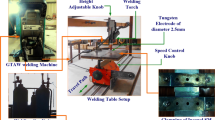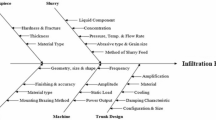Abstract
Creep feed grinding is widely used in manufacturing supperalloy materials. These materials are usually used in aircrafts, gas turbines, rocket engines, petrochemical equipments and other high temperature applications. The objective of this paper is to model and predict the grinding forces of the creep feed grinding of these materials using the neural network. This model is then used to select the working conditions (such as depth of cut, the wheel speed and workpiece speeds) to prevent the surface burning and to maximize the material removal rate. The results show that the combined neural network and an optimization system are capable of generating optimal process parameters. The outcomes of the paper are now used to apply the optimal working conditions for grinding the turbine blades.
Similar content being viewed by others
Abbreviations
- ν s :
-
wheel speed (m/s)
- D :
-
wheel diameter (mm)
- a :
-
grinding depth (mm)
- ν w :
-
workpiece speed (m/s)
- b :
-
width of cut (mm)
- F ν :
-
vertical force (N)
- F h :
-
horizontal force (N)
- Q c :
-
critical energy
- k :
-
thermal conductivity
- ρ :
-
material density
- T i :
-
room temperature (16°C)
- T boiling :
-
boiling temperature (100°C)
- r :
-
surface covering rate
- A g :
-
real contact area
- l :
-
length of contact area
References
Bianchi, E. C. and Silva, E. J., “The grinding wheel performance in the transverse cylindrical grinding of an Eutetic Alloy,” Material Research, Vol. 5, No. 4, pp. 433–438, 2002.
Wang, S.-B. and Kou, H.-S., “Cooling Effectiveness of cutting fluid in creep feed grinding,” International Communications in Heat and Mass Transfer, Vol. 24, No. 6, pp. 771–783, 1997.
Webster, J., Brinksmeier, E., Heinzel, C., Wittmann, M. and Thoens, K., “Assessment of grinding fluid effectiveness in continuous-dress creep feed grinding,” CIRP Annals — Manufacturing Technology, Vol. 51, No. 1, pp. 235–240, 2002.
Sunarto, Y. I., “Creep feed profile grinding of Ni-based superalloys with ultrafine-polycrystalline cBN abrasive grits,” Precision Engineering, Vol. 25, No. 4, pp. 274–283, 2001.
Alagumurthi, N., Palaniradja, K. and Soundararajan, V., “Cylindrical grinding — A review on surface integrity,” International Journal of Precision Engineering and Manufacturing, Vol. 8, No. 3, pp. 24–44, 2007.
Xu, X. P., Yua, Y. Q. and Xub, H. J., “Effect of grinding temperatures on the surface integrity of a nickel-based superalloy,” Journal of Materials Processing Technology, Vol. 129, No. 1–3, pp. 359–363, 2002.
Jain, R. K. and Jain, V. K., “Optimum selection of machining conditions in abrasive flow machining using neural network,” Journal of Materials Processing Technology, Vol. 108, No. 1, pp. 62–67, 2000.
Wang, Z., Willett, P., DeAguiar, P. R. and Webster, J., “Neural network detection of grinding burn from acoustic Emission,” International Journal of Machine Tools & Manufacture, Vol. 41, No. 2, pp. 283–309, 2001.
Jianjun, Y., Yifeng, G., Baiyang, J., Bin, Y. and Jinxiang, D., “Applying an artificial neural network to the control system for electrochemical gear-tooth profile modifications,” International Journal of Precision Engineering and Manufacturing, Vol. 8, No. 4, pp. 27–32, 2007.
Andrews, C., Howes, T. and Pearce, T., “Creep feed grinding,” Rinehart & Winston, 1985.
Jin, T. and Stephenson, D. J., “Investigation of the heat partitioning in high efficiency deep grinding,” International Journal of Machine Tools & Manufacture, Vol. 43, No. 11, pp. 1129–1134, 2003.
Maksoud, T. M. A., “Heat transfer model for creep-feed grinding,” Journal of Materials Processing Technology, Vol. 168, No. 3, pp. 448–463, 2005.
Gin, T. and Stephenson, D. J., “Investigation of the heat partitioning in high efficiency deep grinding,” International Journal of Machine Tools and Manufacture, Vol. 43, No. 11, pp. 1129–1134, 2003.
Wang, S.-B. and Kou, H.-S., “Selections of working conditions for creep feed grinding. Part(II): Workpiece temperature and critical grinding energy for burning,” International Journal of Advanced Manufacturing Technology, Vol. 28, No. 1–2, pp. 38–44, 2006.
Malkin, S. and Cook, N. H., “The wear of grinding wheels, Part 1 — Attritious Wear,” Journal of Engineering for Industry, Trans. ASME, Vol. 93, No. 4, pp. 1120–1128, 1971.
Author information
Authors and Affiliations
Corresponding author
Rights and permissions
About this article
Cite this article
Vafaeesefat, A. Optimum creep feed grinding process conditions for Rene 80 supper alloy using neural network. Int. J. Precis. Eng. Manuf. 10, 5–11 (2009). https://doi.org/10.1007/s12541-009-0040-1
Received:
Accepted:
Published:
Issue Date:
DOI: https://doi.org/10.1007/s12541-009-0040-1




